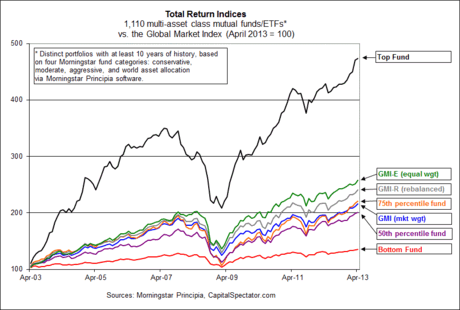Most investors suffer high fees and earn low returns. There are no sure-fire solutions, at least for the second problem, although playing defense by way of investing in a broadly diversified portfolio across the major asset classes with low-cost index products is a good start. This isn’t a silver bullet, but history suggests you can do quite well with this simple strategy. And if you add in a bit of rebalancing, you’ll probably do moderately better still. Not tomorrow, necessarily, but through time the odds usually stack up in your favor with this strategy. This basic advice drives the financial industry crazy because it sounds incredibly easy and doesn’t cost much. It’s hard to charge a lot for a strategy that requires no skill or forecasting prowess. But the results speak for themselves.
Several times a year I like to check in on how passive allocation compares with a broad spectrum of multi-asset-class mutual funds and ETFs, most of which are actively managed and charge a comparatively high fee. As usual, a majority of this group trails the Global Market Index (GMI), an unmanaged value-weighted mix of the major asset classes that’s the standard benchmark on these pages. Reviewing results for the 10 years through the end of April 2013, GMI ended up at the 70th percentile of performance vs. 1,100-plus funds.

Here’s a closer look at how the numbers stack up:

Running the data on a risk-adjusted basis offers similar results, courtesy of my own proprietary database and numbers from Morningstar’s Principia software. The familiar message is that you can do quite well by holding a broad basket of asset classes. The absolute return number is always in doubt of course. But what’s fairly consistent is the relative performance ranking of GMI vs. a broad pool of funds navigating the realm of asset allocation. Indeed, the history above is similar to the rankings posted in January 2013 or a year ago, for instance.
After crunching the numbers several times a year for nearly a decade on this front, the result is usually the same. It’s hard to beat asset allocation when defined across a wide array of asset classes. It’s even harder if the benchmark rebalances the mix on a periodic basis. The historical record is a reminder that we should think twice about second-guessing Mr. Market’s portfolio choices. This sounds like a dumb idea, until you look at the results for a majority of “smart” money managers.
Another dumb idea that ends up looking rather savvy is keeping expenses low, which is quite easy to do with index mutual funds and ETFs. Replicating GMI with ETFs, for instance, can be done for less than 50 basis points, perhaps a lot less, depending on the products you choose. Many of the active funds in the chart above charge two to three times as much.
The power of broad diversification across asset classes, favoring low-cost index funds, and simple rebalancing is a no-brainer that serves as a robust, investable benchmark. Yet relatively few investors take full advantage of this strategy. That’s probably why GMI’s competitive results persist: most investors are doing something else. But innovation seems to come at a steep price in relative and perhaps absolute terms.
Why should we expect GMI and related strategies to remain competitive? For a familiar reason: the future’s uncertain, and that’s not likely to change. If you have a high-confidence forecast on one or more asset classes, you can dispense with broad diversification. That’s standard practice in the financial industry. Unfortunately for investors, the standard practice has an annoying habit of delivering the standard result.
You are cherry picking the data, which magnifies the outcome. How about from a market high to a 10 year market low, i.e., December 1998 to December 2008?
Nice try, Mark, but no dice. I’ve been running these numbers several times a year, for a number of years, and the results are pretty much the same. I don’t republish all the historical data every time I rerun the numbers, although I listed a couple of older updates in this article. I’d encourage you to search through the site to review the previous updates.